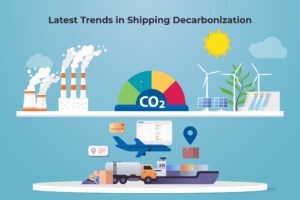Decarbonization in the shipping industry is essential to mitigating the impact of climate change. The maritime sector is responsible for approximately 2.2% of global CO2 emissions, and with the Paris Agreement calling for a reduction in greenhouse gases, it’s more important than ever for the shipping industry to decarbonize. There are a number of ways to decarbonize shipping, from using alternative fuels to investing in energy-efficient technologies. In this blog post, we will explore some of the latest trends in shipping decarbonization and what companies are doing to reduce their carbon footprint.

Logistics and Digitalization
Digital technologies are dramatically changing the maritime industry and its approach to shipping decarbonization. By automating processes and increasing transparency and data sharing, digital tools can help reduce emissions throughout the supply chain.
According to a study by DHL, the implementation of digital solutions could reduce maritime CO2 emissions by up to 30 percent by 2030. One of the most promising areas for digitalization is port operations.
By using drones and other autonomous vehicles for tasks such as surveying, mapping, and cargo handling, ports can significantly reduce their carbon footprint. Other digital solutions that can help reduce emissions in the maritime sector include vessel tracking, fuel management, and weather routing.
Hydrodynamics
The trend toward decarbonization in shipping is being driven by a number of factors, including the need to reduce greenhouse gas emissions, the availability of new technologies, and changing regulations.
Hydrodynamics is one area where there has been significant progress in recent years. New hull designs and propeller types are being developed that can significantly reduce a ship’s resistance to water, resulting in less fuel consumption and emissions.
Some of the latest innovations in hydrodynamics include the use of computational fluid dynamics (CFD) to design more efficient hull shapes, the use of air lubrication to reduce friction between the hull and water, and the use of contra-rotating propellers that cancel out each other’s wake.
The application of these technologies can result in significant reductions in fuel consumption and emissions. For example, CFD-designed hulls have been shown to reduce fuel consumption by up to 10%, while air lubrication can reduce it by up to 20%.
As shipping companies look for ways to reduce their environmental impact, hydrodynamics will continue to be an important area of focus.
Machinery
Over the past few years, there has been a growing interest in decarbonizing the shipping industry. This is due to the sector’s large contribution to global greenhouse gas emissions – estimated at around 2-3% – and the fact that it is forecast to grow significantly in the coming decades. There are a number of different ways to decarbonize shipping, including using alternative fuels, improving energy efficiency, and developing new technologies.
One of the most promising options for decarbonizing maritime transport is the use of liquefied natural gas (LNG). LNG is a cleaner burning fuel than heavy fuel oil, which is currently used by most ships, and emits around 20% less carbon dioxide when combusted. A number of major shipping companies have already made commitments to switch to LNG power, and new vessels are being built with LNG engines. In addition, there are a number of other alternative fuels that could be used for maritime transport, including biofuels, hydrogen, and nuclear power.
Improving energy efficiency is another key way to decarbonize maritime transport. There are a number of initiatives underway to do this, including the development of more efficient ship designs, propellers, and engines. Operational measures such as slow steaming – where ships travel at reduced speeds to save fuel – can also help improve energy efficiency.
Finally, new technologies can play a role in decarbonizing maritime transport.
Fuels and Energy
There is a growing trend in the shipping industry toward decarbonization, as maritime companies seek to reduce their environmental impact and comply with increasingly stringent regulations. One of the key ways in which they are doing this is by switching to cleaner fuels and energy sources.
LNG is one of the most popular alternatives to dirty bunker fuels, and its use is growing rapidly in the maritime sector. LNG emits around half as much carbon dioxide as traditional bunker fuel, making it a much cleaner option. Many shipowners are investing in LNG-powered vessels, and this technology is quickly becoming more mainstream.
Another promising area is the use of renewable energy sources such as solar and wind power. These can be used to supplement or even replace traditional fossil fuels, significantly reducing a vessel’s emissions footprint. There are already a number of ships powered by renewables, and this looks set to become a more common sight in the coming years.
With governments around the world introducing stricter emissions targets, it’s clear that shipping companies need to start making changes now if they want to stay compliant. Switching to cleaner fuels and energy sources is one of the best ways to do this, and it’s an investment that will pay off in the long run.
After Treatment Measure
After-treatment measures are critical for ensuring the success of any shipping decarbonization initiative. Without proper after-treatment, carbon emissions can quickly return to pre-initiative levels.
There are a number of different after-treatment measures that can be taken, but some of the most common and effective include:
- Continued monitoring of emissions levels and trends.
- Regular reporting on progress toward goals.
- Public awareness campaigns to keep people informed and engaged.
- Strict enforcement of regulations.
- Incentivizing good behavior with financial rewards or other benefits.
